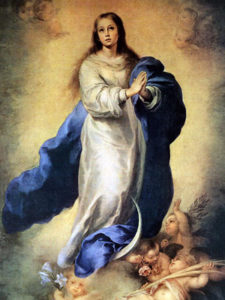Solemnity of the Immaculate Conception of the Blessed Virgin Mary
Scripture:
Genesis 3:9-15, 20
Ephesians 1:3-6, 11-12
Luke 1:26-38
Refleciton:
While today’s feast celebrates the fact that Mary was chosen from the moment of her very conception, the liturgy focuses us more on the response that Mary makes as a young woman. As we see her response to God’s call was wholeheartedly and freely given.
Great artists have portrayed the moment of Mary’s ‘fiat’ (‘yes’) to God in countless images and interpretations. Scholars note that in these classic paintings, beyond the central images of Mary and Gabriel, there are some additional symbols that help to convey the meaning of the event. To highlight but a few we might note:
- That in many paintings we see light passing through a glass window or shining into a walled garden and this symbolises Mary’s chastity. Again many paintings show Mary being offered or holding a lily – again to symbolise virginity.
- The archangel Gabriel is usually painted as winged and traditionally in white and is often seen descending towards Mary – all signs of God’s Word being conveyed to her.
- Mary is often shown with a book open at the prophecy of Isaiah (7:14), ‘A young woman is with child, and she will bear a son. .’ and often artists depict a dove descending upon Mary – delicately suggesting the moment of conception.
In his own way Luke too is an artist. He ‘paints’ the gospel scene with words rather than colours, but he adds details to help us understand the meaning of this moment. His words are transformed under the inspiration of the Spirit to become the Word of God for us. In turn God’s Word opens the door to faith and faith opens us to embrace mystery.
Luke is painting a portrait more than reporting an encounter. So let us meditate on the scene and look more closely at the way Luke ‘paints’ the portrait of Mary’s response.
First we notice the extraordinary means of God’s communication – an angel. Something rare and usually reserved for those moments when heaven and earth seem to touch. It’s as if God’s word- in the form of the message brought by Gabriel – literally steps from one plane of existence to another; from heaven to us.
But today it may also be helpful for us to reflect on how Mary comes to the point where she can give her wholehearted response.
Let’s look to some of the words Luke chooses to use. “Mary was greatly troubled at what was said and pondered what sort of greeting this might be” She is afraid, (“Do not be afraid Mary” says the angel). Mary asks the question that arises so logically in the face of this mysterious message “How can this be, since I have no relations with a man?”
Each of these statements seem to point us towards the human response of Mary. They illustrate that Luke is carefully presenting Mary as one like us, as a young woman who must struggle to understand and then respond to God’s word. Like us, Mary seeks to know and understand what lies ahead of her even as she prepares to take a leap in faith and give ‘fiat’ her response of ‘yes’ to God.
A significant moment is when Mary is reassured of God’s faithfulness in the experience of her cousin Elizabeth – And behold, Elizabeth, your relative, has also conceived a son in her old age, and this is the sixth month for her who was called barren; for nothing will be impossible for God.”
Perhaps two key lessons lie here for us. Firstly, like Mary we are challenged to listen for God’s Word to us and to respond to it wholeheartedly. This may take time and we may have to work at making this response. The important thing is to make a generous response to God no matter how long our ’fiat’ might be delayed. Secondly, looking to Elizabeth’s trust in God, let us never underestimate the power of our own example of faithfulness – our witness might just be the key to helping someone else respond wholeheartedly to God.
Fr. Denis Travers, C.P., is a member of Holy Spirit Province, Australia. He currently serves on the General Council and is stationed in Rome.
